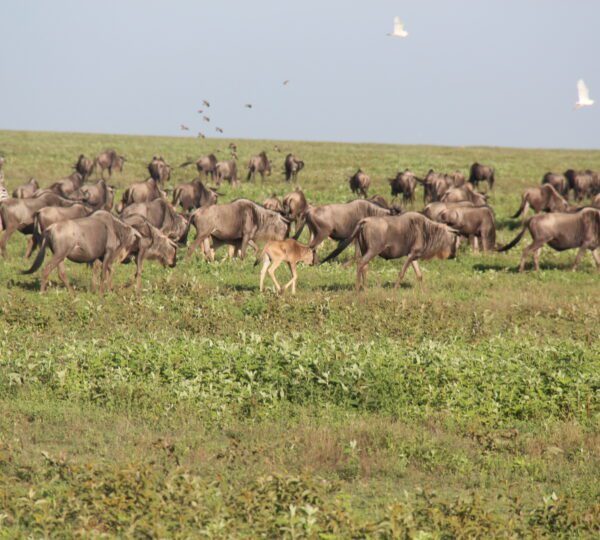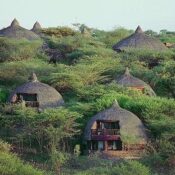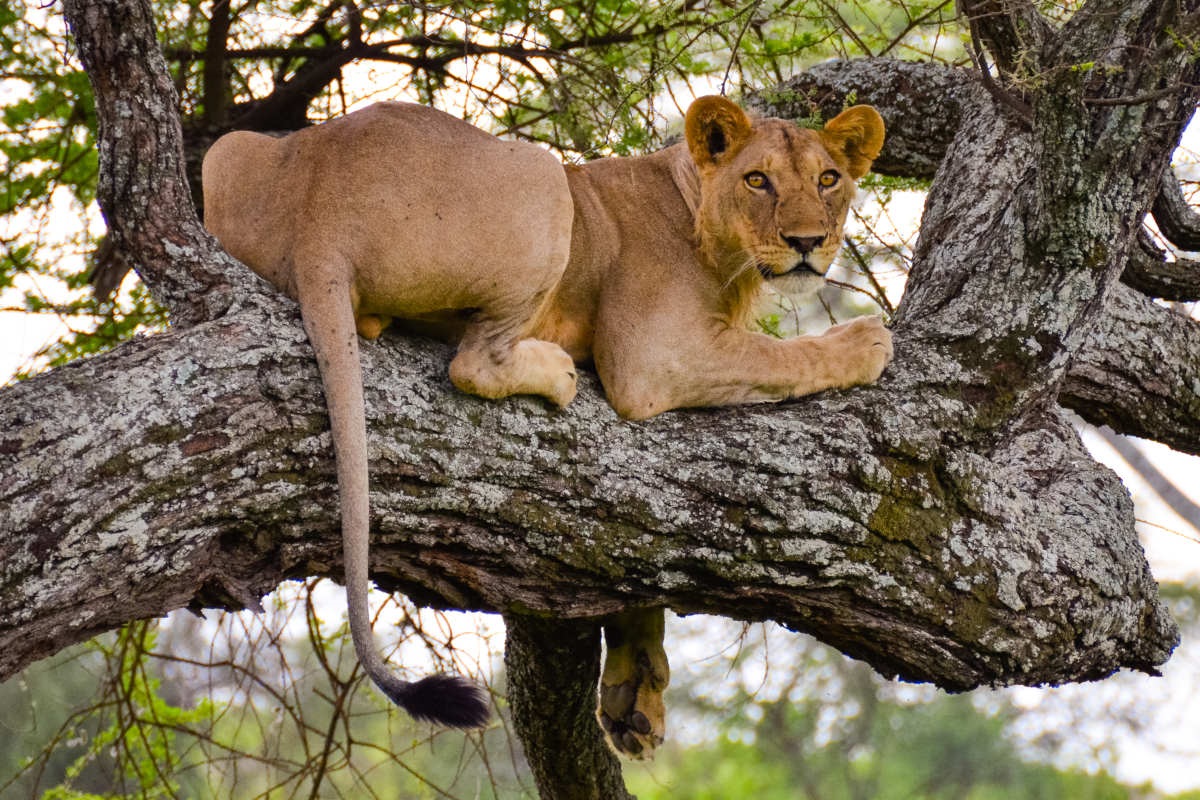Best Time to Witness the Serengeti Great Migration

Best Time to Witness the Serengeti Great Migration
Want to see Tanzania’s wildlife in its full splendor? Then, visit during the best time to witness the Serengeti great migration.
The Great Migration is East Africa’s most bucket-list-worthy safari experience. Each year, 1.4 million wildebeest, a round trip between Tanzania and Kenya, accompanied by hundreds of thousands of zebra, and gazelle.
The mind-boggling numbers attract wildlife lovers from around the globe to watch the suspenseful river crossings or the 500,000 newly born wildebeest calves take their first steps.
But did you know the Great Migration isn’t a one-and-done event? It’s a year-round cycle, with each month offering a different experience. In this guide, you’ll find a complete breakdown on when is the best time to see the Great Migration and which of the Serengeti’s four regions has the best front-row seat to all the action.
The Great Wildebeest Migration holds the title of “The Greatest Wildlife Show on Earth” for a reason. Each year, roughly between May and December, millions of wildebeest, zebra, and gazelle begin a roundtrip journey between Tanzania’s Serengeti National Park and Kenya’s Maasai Mara. With hungry predators following their every move, it sets the scene for an unforgettable safari experience. But this event isn’t wholly predictable.
It’s a natural phenomenon and depends on the rains, environmental factors, and animals.
Think of the below breakdown as a general guideline of the best time to see the Great Migration.
“What happens if you’re visiting Tanzania outside of these months?” you ask.
Well, you’ll still see animals. The Serengeti is vast, and there are millions of animals involved so you’re bound to witness the herds walking across the endless plains.
The best time to see the great migration: Month-by-month breakdown
The Great Wildebeest Migration is one of the most amazing natural phenomena on earth. From July to October, an incredible number of animals migrate from Tanzania’s Serengeti plains across the Mara River and into Kenya’s Masai Mara Reserve.
It’s a breathtaking sight that you won’t want to miss! Here’s when to see the migration, month-by-month.
December to March: The great migration calving season

Wildebeest on the Move: Witness the Ndutu Migration with Their Newborn Calves
Love baby animals. The Southern Serengeti is where the circle of life begins in Tanzania. The herds make their way from the Central Serengeti and move between the Ndutu area and the Ngorongoro Conservation Area, where the calving season begins.
The rain has dried up by January, leaving a buffet for the herbivore herds in its wake. The wildebeest feast on the newly sprouted grasses around Lake Ndutu and Kusini as the females prepare to give birth.
Between late January and March, around 8,000 calves are born a day. That’s a grand total of 500,000 wildebeest!
Within 10 minutes after birth, the calves take their first steps and get ready to move with the massive herd. This gives rise to predator action as the massive herd has to defend its newborn from hungry carnivores.
If seeing this incredible spectacle is high on your bucket list, this is one of the best periods to book a Great Migration safari in Tanzania.
April to May: The herds move from Ndutu to central Serengeti
Leaving behind a barren landscape in the south, the wildebeest herds follow the call of thunderstorms to the Central Serengeti.
Book a safari between April and May, and you’ll see massive herds move through the Moru Kopjes towards the Western Corridor. Here, the animals congregate in the thousands on the banks of the Mbalageti and Grumeti rivers.
The only problem? It’s a treacherous river crossing with crocodiles and other predators lying in wait.
How to see the great migration herds
Want to maximize your chances of seeing the river crossings and new-born calves? Here’s what you can expect from the different transport options for Serengeti National Park.
Self-drive

Can you self-drive in Serengeti National Park? Yes, you can! That said, we don’t recommend it. The Serengeti is vast (it’s 14,763 square km), and you can easily get lost. You’ll also need to have a 4WD vehicle, and some of the roads (like the one running from Naabi Hill gate to Seronera) are notorious for their rough driving conditions.
If you do decide to go with a self-drive option:
- Make sure you plan your route well in advance.
- Hire a 4WD vehicle.
- Hire a guide to help you navigate around the park.
Guided safari package
A guided safari tour is the best way to get around the Serengeti and see the Great Migration herds.
You can book various package options to suit your needs ranging from budget-friendly tented camps to Tanzania’s top luxury lodges. All the options include a certified safari guide and vehicle, leaving you to sit back and enjoy the experience.
The advantages of signing up for a guided safari package:
- Includes accommodation, park fees, transfers, and game drives.
- Professional guides who know how to navigate the park and where the herds gather.
- It saves you time, and you don’t have to figure out everything by yourself.
Hot air balloon safari

For something different (that you’ll rave about for years), book a hot air balloon safari over the Serengeti.
Taking off before sunrise, you’ll watch the landscape come alive and silently glide past the massive herds of wildebeest and other wildlife.
It’s a unique way to see the Great Migration and get a birds-eye view of the immense scale of the Serengeti and the roaming herds.
Great migration FAQ
- What months are the Great migration? July to October are traditionally the best months to see the river crossings. However, you can watch the herds move across the Serengeti throughout the year.
- When is the best time to see the great migration in Tanzania? The best months to see the Great Migration are between July and October. The herds are making the treacherous Mara River crossing, creating the perfect storm for a dramatic safari experience with predators lurking on land and in the water.
- When is calving season? The Great Migration calving season is between the end of January to March.
- What month is best to see the dramatic river crossing? July to August are the best months to see the Mara River crossing. However, the herds cross back and forth between September and October until migrating to the Central and Southern Serengeti.





